

What is a Social Network?
Social networks are graphs where the nodes represent humans (or agents), and edges are created voluntarily by agents according to the agent’s criterion.
Hashkat is a light weight, open source social network generator, which can generate graphs of 10,000 agents in less than 2 minutes on an ordinary laptop.
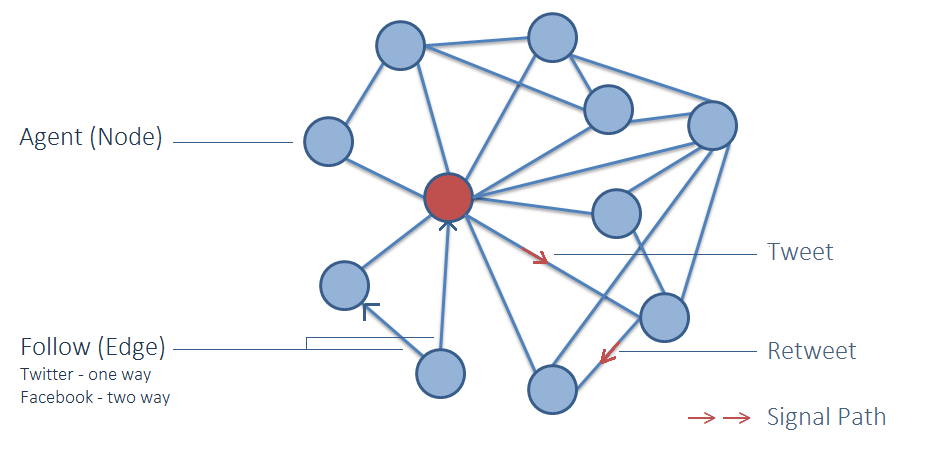
Agents
The building block of the social network is the agent.

Agents are configured with different rates:
- Add weight: rate the agent is added to network
- Follow weight: rate agent IS FOLLOWED BY other agents
- Follow rate: rate agent FOLLOWS other agents
- Tweet rate: rate agent generates tweets
- Tweet_type: proportion of tweets of each type agent generates. The 4 tweet_types are: plain, humorous, ideological & musical.
- Followback rate: the rate at which an agent will follow an agent that has followed the agent (on Facebook this is 100%, all follows are mutual, on Twitter this varies, experimentally shown to be 44% for ordinary users).
- Hashtag: care about region/ideology: if an agent follows another based on a #hashtag in their signal, the agent’s choice to follow will depend on tweeter’s region or ideology.
A sample agent configuration is shown below.

Rates are normalized, so if a standard agent has an add_weight of 50 and a celebrity agent has an add_weight of 7, standard agents will be added with 50/(50+7) or 87.7% of the time.
The default configuration of Hashkat has two Agent_types pre-configured, Standard and Celebrity. To run a single agent simulation set one add_weight to zero.
The deluxe configuration of Hashkat has seven Agent_types pre-configured:
- Standard
- Celebrity
- Humorist
- Ideologue
- Company
- Government
- Bot
Rates for the different Agent_types are pre-set to match our current understanding of each Agent_type’s behavior in Twitter, with the caveat that we do not have full information.
Users may change any and all parts of any agent configuration.
Up to 200 Agent_types may be configured in the default build of Hashkat, and an unlimited number if the build is reconfigured.
A network is configured in: hashkat\INFILE.yaml which is created from hashkat\DEFAULT.yaml
The build parameters may be changed in: hashkat\src\config_static.h
Follow Models (Edge Creation)
Now that we have agents, how do they “chose” to follow other agents?

Hashkat has 6 follow models that specify how edges are created between agents.
Each model has a different basis in graph theory. The models are:
- Random (Erdos –Renyi)
- Preferential Attachment (Barabasi-Albert)
- Agent
- Agent Preferential Attachment
- Hashtag
- Combination of above (called “Twitter” in Hashkat)
- Follow Back
Random: a random choice of whom to follow.
Preferential Attachment: an agent choses to follow the agent in the system with the most followers (highest in-degree).
Agent: an agent_types is preferred to be followed, for example, Celebrities. At present in Hashkat this is set in the 'Follow_weight' of the agent type, that is, all agent_types in the system will prefer to follow Celebrities at the same rate. Within the agent_type, which specific agent is followed is random.
Agent Preferential Attachment: within the agent_type, i.e. Celebrity, the agent will prefer to follow the most popular Celebrity.
Hashtag: a user specified proportion of tweets will have #hashtags which show the region and ideology of the tweeter. If randomly presented with a tweet with a hashtag, if an agent “cares about” region or ideology, the agent may chose to follow the tweeter if the tweeter is of the SAME region or ideology as the receiving agent.
Combination: a combination of the above follow models may be chosen by the user for network behavior, to model the fundamental characteristic of human groups: diversity.
Follow-back: the choice to follow another agent based on their choice to follow you. On Facebook, all follows must be mutual (100% follow-back). On Twitter, experiments have shown varying rates of follow-back, with normal users following back 44% of the time. In Hashkat, follow-back rate is set by agent_type, i.e. Celebrities have low follow-back rates.
Tweet (Signal) Generation
Now that we have nodes(agents) and edges(follows) what do we do with them?
Social networks exist to exchange signals between agents.

In Hashkat agents may create 4 types of tweets:
- Plain
- Ideological
- Humorous
- Musical
Tweet_type is hard-coded and affects retweet rates.
Musical tweets are so named because they are 'language free' any agent can 'read' them.
Unfollowing (Edge Deletion)
In Hashkat, edge deletion (unfollowing) is based on absolute or relative 'chattiness' of an agent.
Chattiness: tweet rate.
Absolute chattiness: if an agent GENERATES tweets in excess of a (user specified) global rate, the generating agent will lose a RANDOM follower.
Relative chattiness: if an agent is RECEIVING tweets from another agent at double the rate the receiving agent usually receives tweets, the receiving agent will unfollow the chatty agent.
Populations in Regions
Now that we have Agents (nodes), Follows (edges) and Tweets, how do we create a more human social simulation? Hashkat has created Regions, that define the population in terms of:
- Language
- Ideology
- Retweet preferences

Agents are generated within Regions according to specified Region parameters in addition to their agent_type parameters.
Let me describe each factor, then I will show how they come together in the creation of Region populations.
Language

Hashkat, created in Ontario, Canada, North America, is currently hardcoded with three languages:
- English
- French
- Spanish
plus one bilingual language:
- French + English
Agents only follow agents who speak the same language they do. Tweets are generated in the language of the tweeter.
A receiving agent cannot 'understand' a tweet if it is not generated in a language they speak, unless the tweet_type is 'musical'.
An agent will not retransmit a tweet that is not in the same language the receiver speaks, unless it is 'musical'.
Ideology
Ideology in Hashkat is conceived of as any belief or defining characteristic.
The default ideologies in Hashkat have color names: red, blue, green & orange. Ideologies may be named by the user and may be unlimited in number.

If an agent generates tweet with a #hashtag, the tweet will contain the ideology flag (color) of the tweeter.
If an agent generates an ideological tweet, the content will be the color of the tweeter.
Agents may read tweets of any ideology if sent by an agent they follow.
Agents may chose to retweet signals of the same ideology at a different rate than those of a different ideology.
Retweet Preference Classes
Regardless of ideology, language, region or agent type, persons retransmit different content according to their own views of importance.
As an example, my uncle and I are both on Twitter. We share a region, language, ideology and agent_type, yet I retransmit anything containing a cute mammal, while my uncle retransmits political content. Clearly I will live longer because I have the better zen.

Retweet preference classes in Hashkat are intended to mimic this different retweeting behavior.
A preference class defines different retweet rates by tweet_type and by agent_type of the sender, and is independent of language, ideology, region or agent_type.
The code for a sample preference class is shown below.
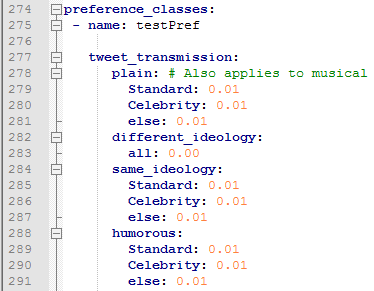
The effect of the preference class is to preferentially retweet some types of tweets.

Regions
These three additional characteristics:
- Language
- Ideology
- Preference Classes
are applied to populations in Regions.
Regions are created, then agents are created within the Regions according to agent_type add_weights AND as citizens of the region with appropriate region characteristics applied
Sample code for region configuration is shown below.

Number of Agent_types = Agent_types x Languages x Ideologies x Preference Classes X Regions
By making these different and independent parameters, the diversity of Hashkat agents is greatly increased.

Program Information
Hashkat may be installed on iOS or Linux/Ubuntu systems.
Hashkat is open source and available on GitHub as hashkat.
The program is fully documented with explanation & tutorials.
Hashkat has a C++ engine and Python (v.2.7) configuration INFILE.

Output
Each simulation produces an Output directory with numerous analysis files (sample shown).
Visualization files are created for Python (.py) or open source Gephi (.gexf) for agent sizes under 10,000.

Below is the main_stats.dat output file for a small simulation of 10,000 agents.
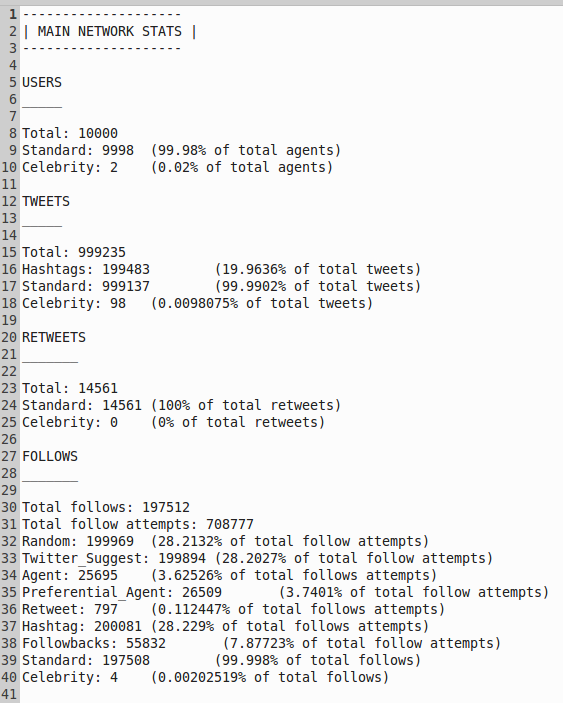
A sample retweet_viz.gexf file is shown, as visualized in Gephi open source software.
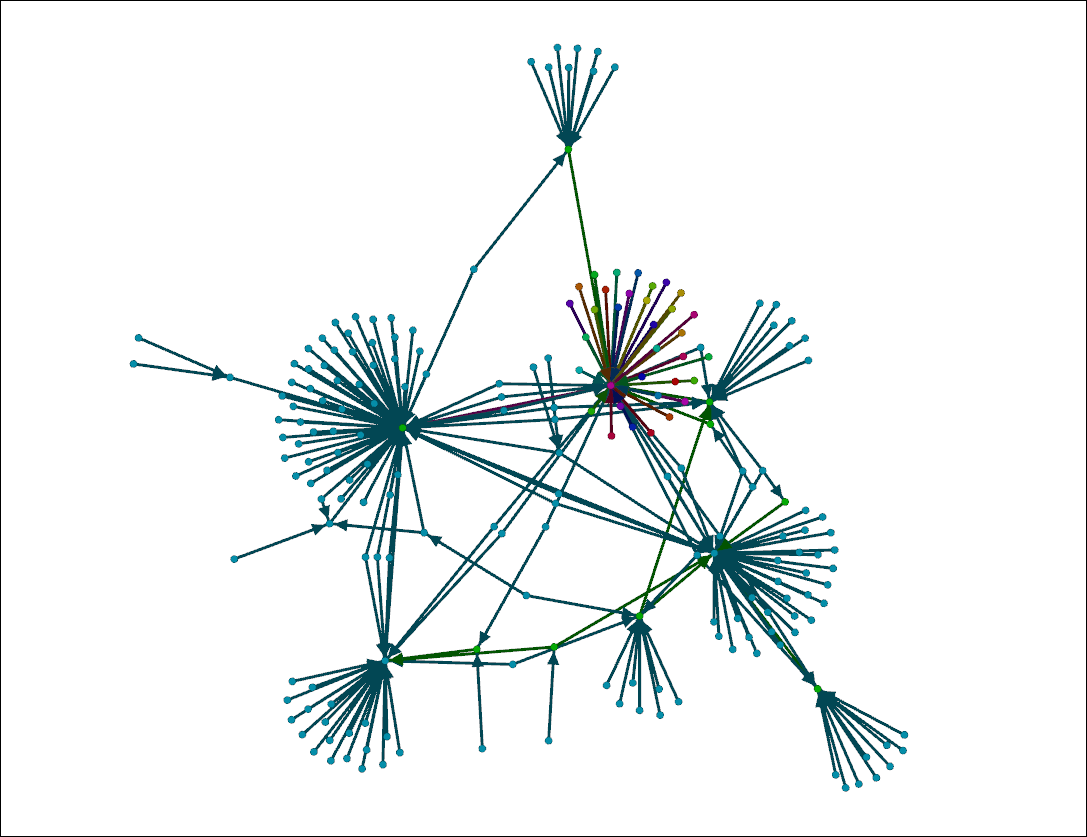
KMC
Hashkat uses a Kinetic Monte Carlo engine to do rate generation.
Rates for adding agents, tweeting, retweeting, following, being followed, unfollowing, Hashtag generation, tweet type, region population characteristics (language, ideology, retweet preference classes) are combined into a Rate Spectrum (R).
At each time increment, a Rate Spectrum is created, a random number is generated, and based on that number, a choice is made.
The image below shows a simplified version of this process.
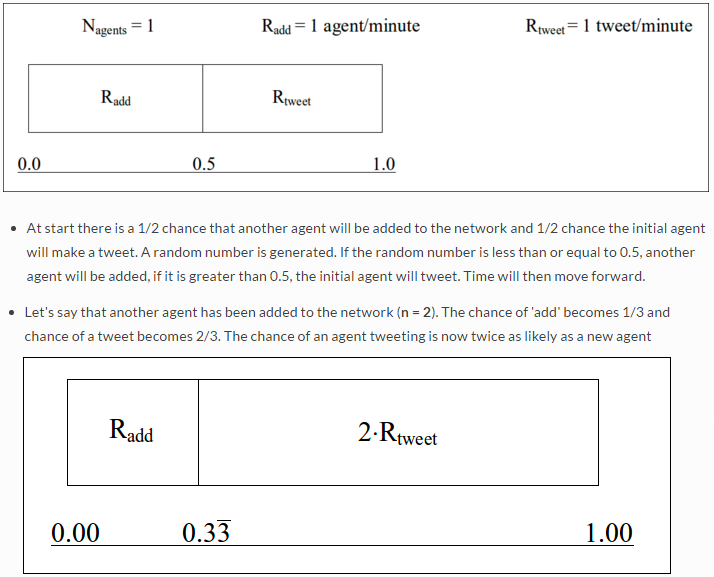
Program Flow
For advanced users, the program flow of Hashkat is as follows:
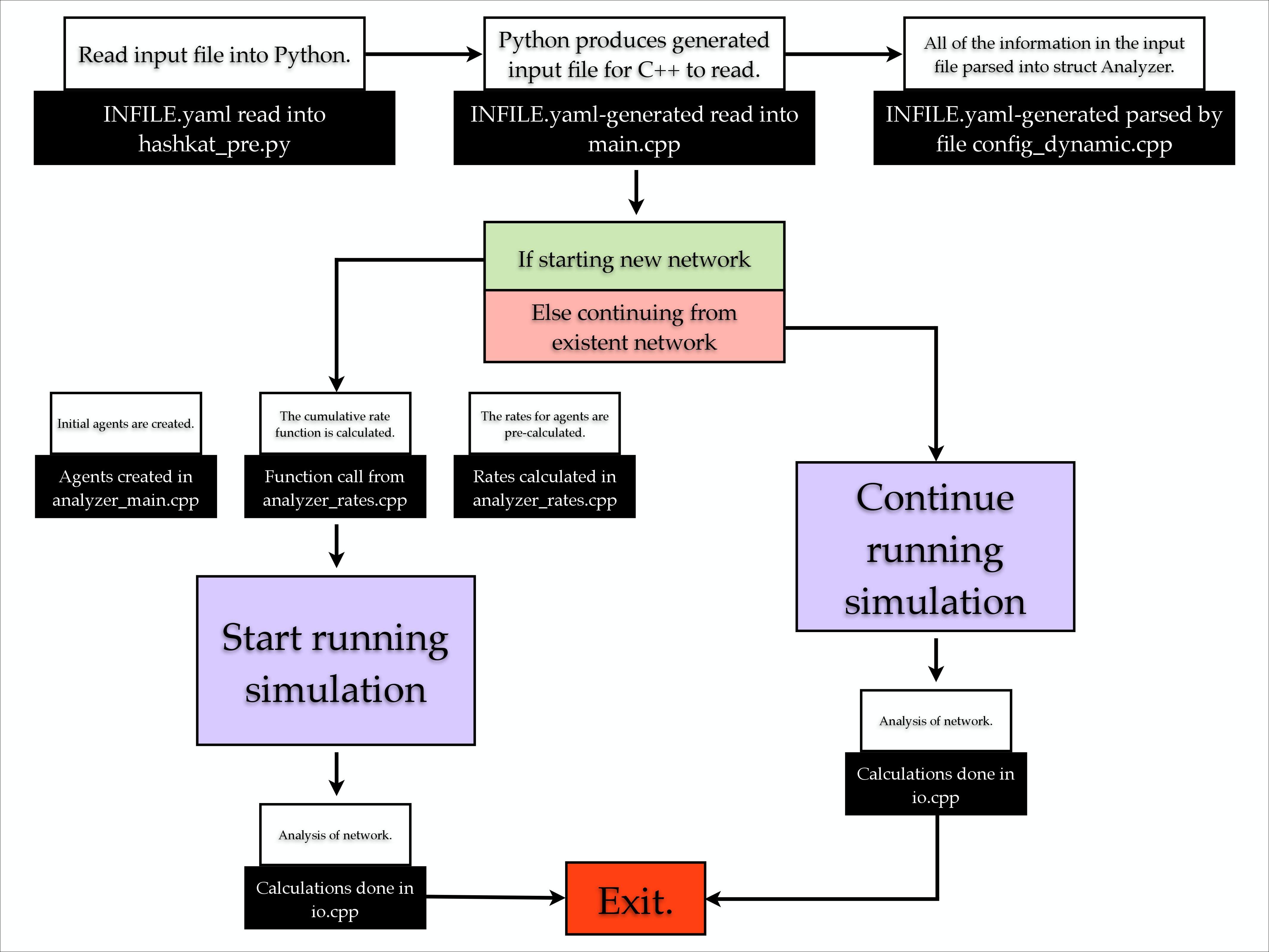
Hashkat runs very quickly. 10,000 agents may be created within 2 minutes.
Maximum number of agents, growth rates, and real time limits set in hashkat/INFILE.yaml & hashkat/src/config_static.h.
Growth rates and other rates may be constant, linear, or quadratic.
Degree distributions and analysis files produced for every simulation.
Simulations may be stopped, reconfigured, and restarted, for example, to model changing ideological composition of population.
Default Hashkat parameters are:
- 3 regions
- 4 ideologies
- 6 preference classes
- 200 agent_types
Languages, Tweet_types & Follow Models are hard coded.
User POV
For the general user interested in generating a social network:
-
Hashkat is downloaded and installed in /hashkat/
-
Gephi and other open source files are downloaded and installed per Installation.
-
In terminal Hashkat is built with command: ./build.sh
-
Between runs, the hashkat/Output directory must be discarded
-
A default INFILE.yaml is generated by the build hashkat/INFILE.yaml.
-
The user desired network is configured in hashkat/INFILE.yaml
-
The simulation is run in terminal with command: ./run.sh
-
The Output directory with analysis files is generated.
-
The hashkat/Output directory must be saved under a different name or discarded before another simulation can be run.
Documentation
More information on every aspect of Hashkat is available at our website.
Documentation by Nick Buhagiar & Linda Kettle.